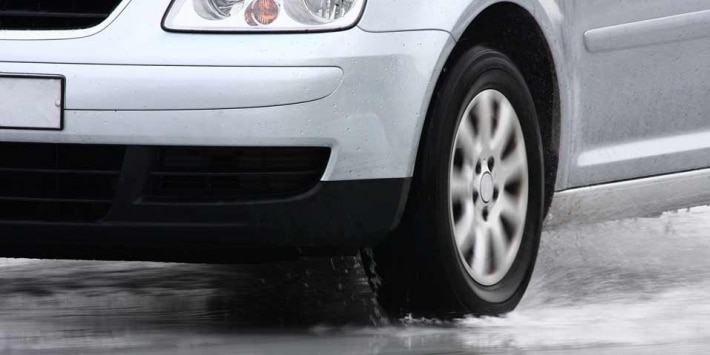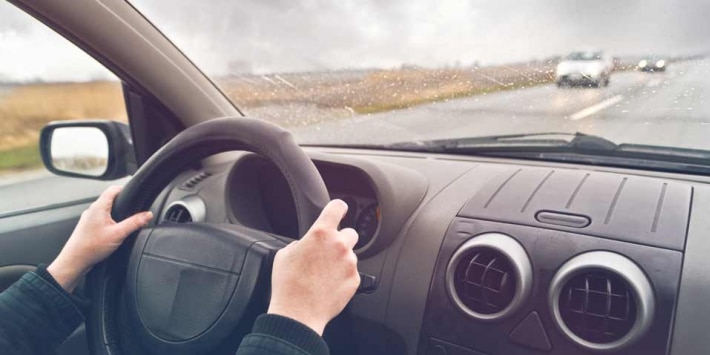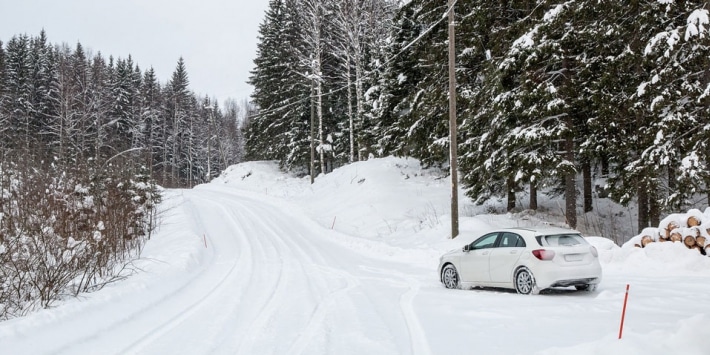Summer thunderstorms, winter weather, rain can be surprising on the road all year round. To drive in wet conditions, without taking risks, you need to adopt good reflexes. But, above all, your main asset is the condition of your tyres.

Apart from setting off on long journeys, we rarely check the weather forecast before taking the car out. So, rezulteo will share some advice and reflexes to adopt if there is a sudden downpour: driving in rain must be learned! From tyres to driving tips, you will learn everything you need to know to keep safe in wet conditions.
Driving in rain: how to equip your car?
To drive in rain, your vehicle must guarantee your safety and give peace of mind for your journey. For this, you must check the condition of your car regularly:
- check if your front and rear windscreen wipers are in good condition.
- check the level of tyre wear: the minimum legal tread depth is 1.6 mm. For your safety, set the limit at 3 mm for summer and all-season tyres and 4 mm for winter tyres. A deep tread evacuates more water reducing any risk of aquaplaning. You can also quite simply monitor the wear indicators.
- check the condition of your tyres: wear must be regular, even at the grooves which must not be deformed.
- check if the tyre pressure is correct: under-inflated tyres deliver poor grip and increase the risk of aquaplaning.
- check the car lights are working correctly.
Adapt your speed to drive in rain
In wet weather, the risk of an accident is multiplied by two. So, you need to take all the necessary precautions when you get behind the wheel of your car. How do you drive in rain without putting yourself in danger?
On the speed side, slow down immediately and increase the distance with the car in front of you. Sudden braking can happen all too quickly in bad weather. Even equipped with the most efficient tyres, your car requires a longer stopping distance on wet roads than on dry roads. Don’t wait until the last minute to brake, try to anticipate.
Expert’s advice: leave a distance equivalent to at least 4 seconds between you and the car in front of you.
In heavy rain, when visibility is reduced, all drivers must reduce their speed which is limited to 50 km/h on all road networks. Do not accelerate quickly.
As you approach a corner, brake progressively on the straight before reaching the bend. This action will avoid causing under steering, i.e. when the front tyres lose grip first. In corners, maintain a moderate speed.
Stay focused, keep control on the road and hold the steering wheel with both hands. On very wet roads, you will meet lorries and other vehicles driving faster than you which will project water and reduce your visibility temporarily. If you overtake pedestrians or cyclists, slow down as you reach puddles.
Things to know: you feel the car slide? In the event of aquaplaning, lift your foot of the accelerator, but do not brake! Tyres may lack grip and behave as if you were driving on a skating rink. When you feel you are losing control, lift your foot of the accelerator and use the engine brake until the tyres start to grip again.
In bad weather, anticipation is the behaviour to adopt to avoid road hazards. Just like when driving on snow and ice, avoid sudden steering movements when driving in rain.
If you lose grip, the best thing to do is slow down to improve the contact with the asphalt. Tyres will maintain better contact with the road and deliver more traction at a reduced speed.
Good to know : observe the traces left by the other vehicles. If they are straight, this means that not enough water has been evacuated from the road and you need to reduce your speed even more.
Useful reflexes to drive in rain
As soon as rain starts to fall, the first thing you need to do is check that your car has its dipped headlights turned on. As stated in the Highway Code, you need to see the road, but you also need to be seen. But avoid turning on the fog lights which will dazzle the other drivers.
Before condensations forms on the windows and windscreen, turn on the ventilation or the air conditioning. Since visibility is already reduced in heavy rain, you are not going to suffer the consequences of condensation!
Rain is the cause of an increased number of mechanical breakdowns of vehicles: indeed, the humidity can cause damage to engines and electrical circuits. If your car breaks down, it is not recommended to open the bonnet which could cause additional damage.
If you find yourself driving through deep water (floods, flash floods, etc) and you have stalled? Above all, do not try to start the engine. You risk making the break down worse.
In summary, how should you drive in rain without putting yourself in danger?
- stop and wait for the shower to end
- turn on the heating, demist the windows
- turn on the dipped headlights
- reduce your speed
- keep a safe distance between vehicles




